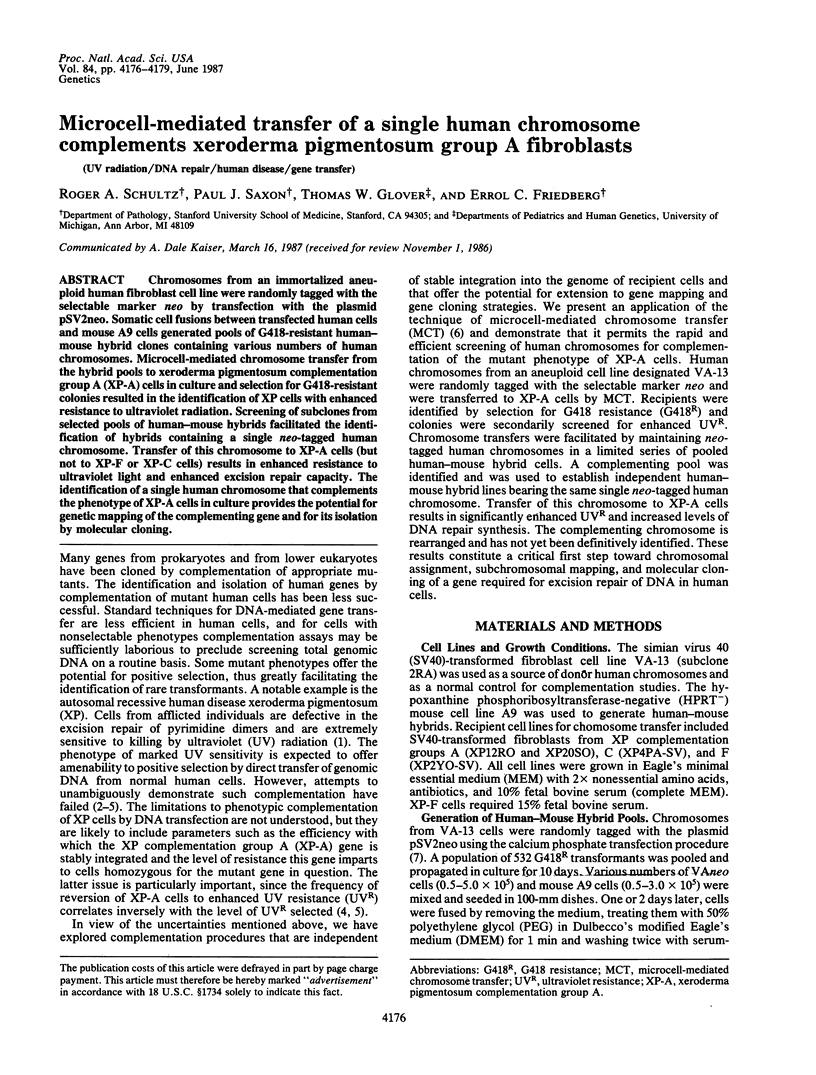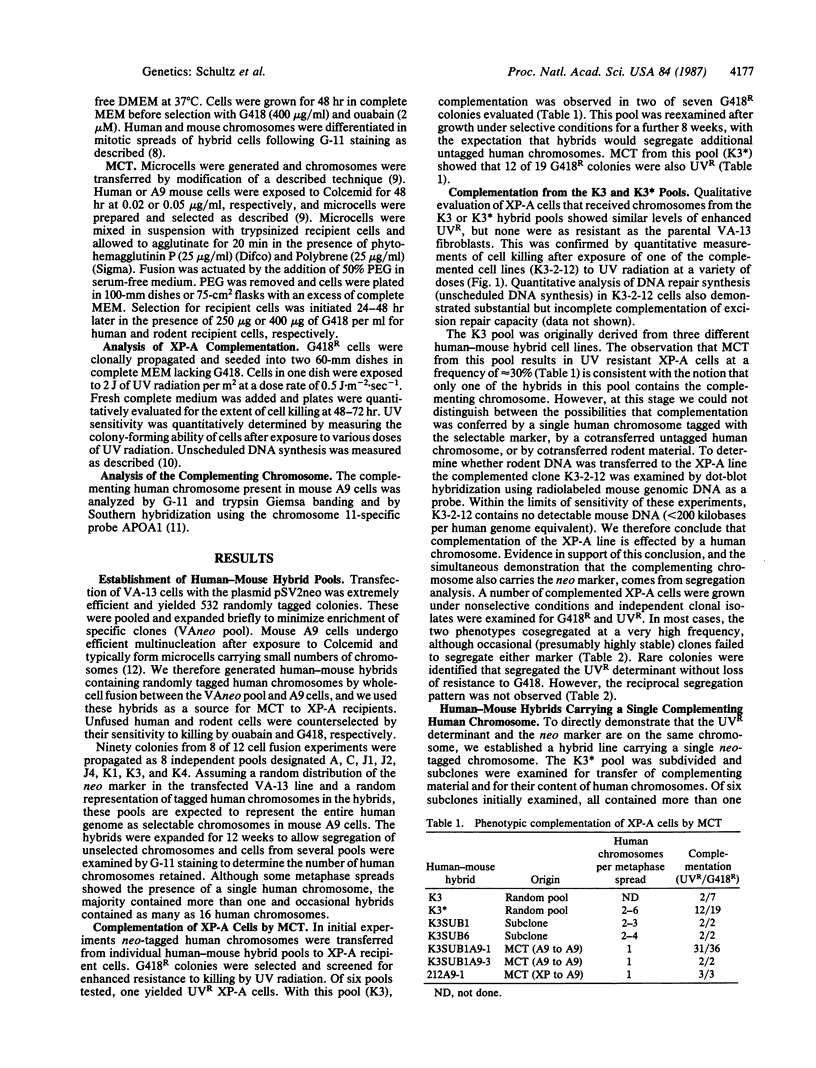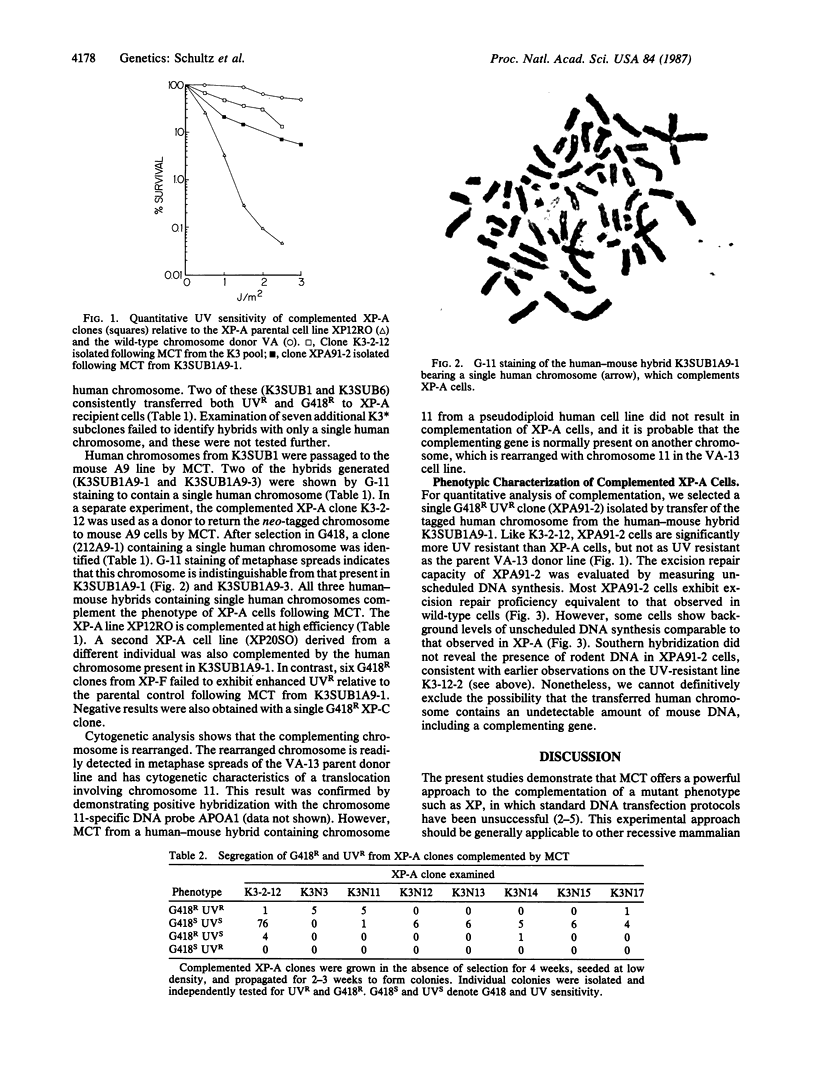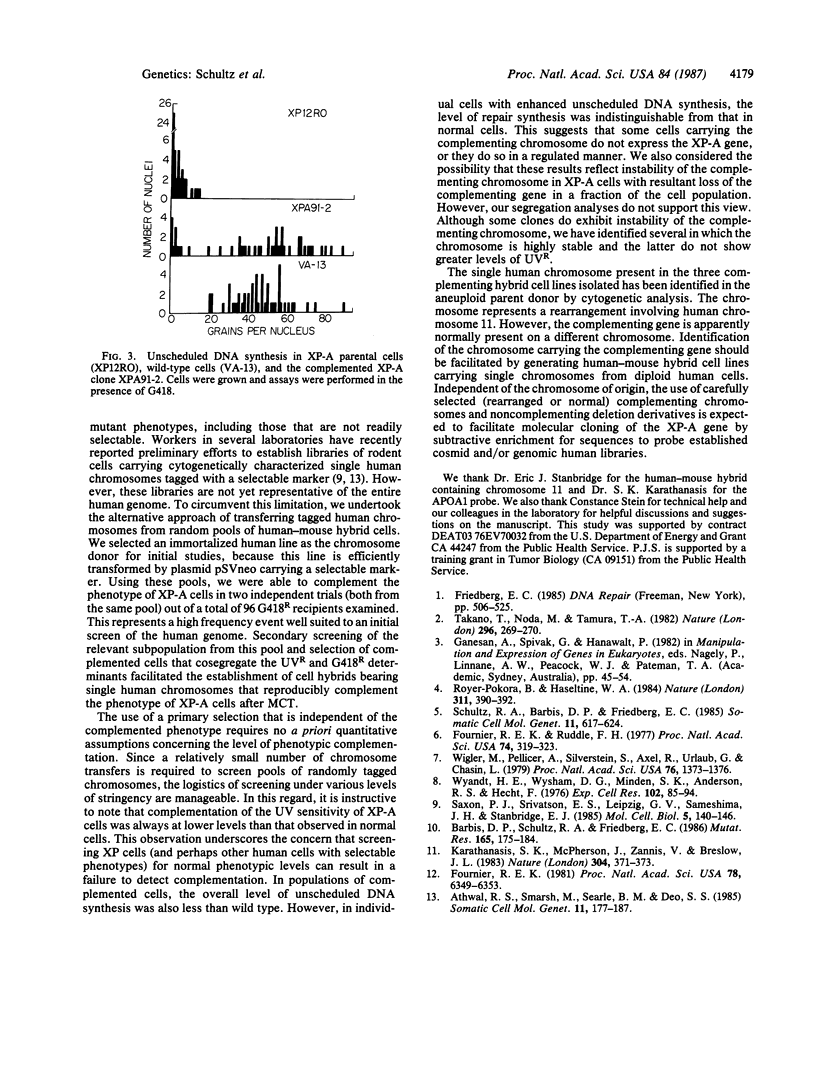Abstract
Chromosomes from an immortalized aneuploid human fibroblast cell line were randomly tagged with the selectable marker neo by transfection with the plasmid pSV2neo. Somatic cell fusions between transfected human cells and mouse A9 cells generated pools of G418-resistant human-mouse hybrid clones containing various numbers of human chromosomes. Microcell-mediated chromosome transfer from the hybrid pools to xeroderma pigmentosum complementation group A (XP-A) cells in culture and selection for G418-resistant colonies resulted in the identification of XP cells with enhanced resistance to ultraviolet radiation. Screening of subclones from selected pools of human-mouse hybrids facilitated the identification of hybrids containing a single neo-tagged human chromosome. Transfer of this chromosome to XP-A cells (but not to XP-F or XP-C cells) results in enhanced resistance to ultraviolet light and enhanced excision repair capacity. The identification of a single human chromosome that complements the phenotype of XP-A cells in culture provides the potential for genetic mapping of the complementing gene and for its isolation by molecular cloning.
Full text
PDF



Images in this article
Selected References
These references are in PubMed. This may not be the complete list of references from this article.
- Athwal R. S., Smarsh M., Searle B. M., Deo S. S. Integration of a dominant selectable marker into human chromosomes and transfer of marked chromosomes to mouse cells by microcell fusion. Somat Cell Mol Genet. 1985 Mar;11(2):177–187. doi: 10.1007/BF01534706. [DOI] [PubMed] [Google Scholar]
- Barbis D. P., Schultz R. A., Friedberg E. C. Isolation and partial characterization of virus-transformed cell lines representing the A, G and variant complementation groups of xeroderma pigmentosum. Mutat Res. 1986 May;165(3):175–184. doi: 10.1016/0167-8817(86)90052-0. [DOI] [PubMed] [Google Scholar]
- Fournier R. E. A general high-efficiency procedure for production of microcell hybrids. Proc Natl Acad Sci U S A. 1981 Oct;78(10):6349–6353. doi: 10.1073/pnas.78.10.6349. [DOI] [PMC free article] [PubMed] [Google Scholar]
- Fournier R. E., Ruddle F. H. Microcell-mediated transfer of murine chromosomes into mouse, Chinese hamster, and human somatic cells. Proc Natl Acad Sci U S A. 1977 Jan;74(1):319–323. doi: 10.1073/pnas.74.1.319. [DOI] [PMC free article] [PubMed] [Google Scholar]
- Karathanasis S. K., McPherson J., Zannis V. I., Breslow J. L. Linkage of human apolipoproteins A-I and C-III genes. 1983 Jul 28-Aug 3Nature. 304(5924):371–373. doi: 10.1038/304371a0. [DOI] [PubMed] [Google Scholar]
- Royer-Pokora B., Haseltine W. A. Isolation of UV-resistant revertants from a xeroderma pigmentosum complementation group A cell line. 1984 Sep 27-Oct 3Nature. 311(5984):390–392. doi: 10.1038/311390a0. [DOI] [PubMed] [Google Scholar]
- Saxon P. J., Srivatsan E. S., Leipzig G. V., Sameshima J. H., Stanbridge E. J. Selective transfer of individual human chromosomes to recipient cells. Mol Cell Biol. 1985 Jan;5(1):140–146. doi: 10.1128/mcb.5.1.140. [DOI] [PMC free article] [PubMed] [Google Scholar]
- Schultz R. A., Barbis D. P., Friedberg E. C. Studies on gene transfer and reversion to UV resistance in xeroderma pigmentosum cells. Somat Cell Mol Genet. 1985 Nov;11(6):617–624. doi: 10.1007/BF01534726. [DOI] [PubMed] [Google Scholar]
- Takano T., Noda M., Tamura T. Transfection of cells from a xeroderma pigmentosum patient with normal human DNA confers UV resistance. Nature. 1982 Mar 18;296(5854):269–270. doi: 10.1038/296269a0. [DOI] [PubMed] [Google Scholar]
- Wigler M., Pellicer A., Silverstein S., Axel R., Urlaub G., Chasin L. DNA-mediated transfer of the adenine phosphoribosyltransferase locus into mammalian cells. Proc Natl Acad Sci U S A. 1979 Mar;76(3):1373–1376. doi: 10.1073/pnas.76.3.1373. [DOI] [PMC free article] [PubMed] [Google Scholar]
- Wyandt H. E., Wysham D. G., Minden S. K., Anderson R. S., Hecht F. Mechanisms of giemsa banding of chromosomes. I. Giemsa-11 banding with azure and eosin. Exp Cell Res. 1976 Oct 1;102(1):85–94. doi: 10.1016/0014-4827(76)90302-5. [DOI] [PubMed] [Google Scholar]



